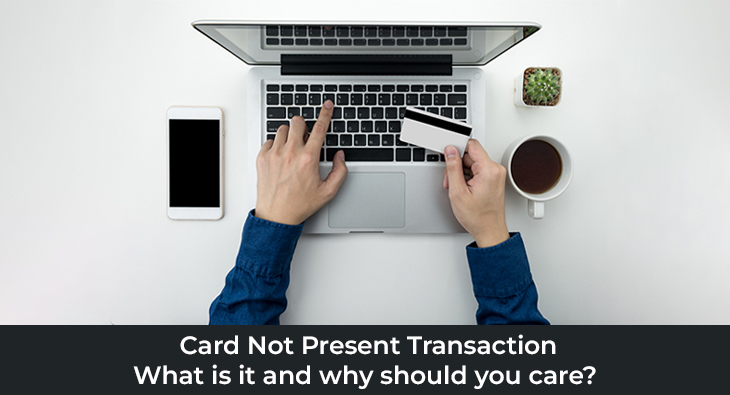A Card Not Present transaction, also known as a CNP transaction, is a type of payment transaction where the physical card is not used or present. It’s becoming increasingly common with the rise of e-commerce and digital payments. In this blog post, we will explain what a Card Not Present transaction is and why it’s important for businesses and customers to be aware of it.
What is a card not present transaction?
A card, not present (CNP) transaction is a payment made with a debit or credit card that doesn’t involve the physical presence of the card. Instead, the card details are input into an online form, typically during e-commerce transactions. This type of transaction exposes the merchant to greater risk since they do not have the opportunity to validate the cardholder’s identity. Examples of CNP transactions include online purchases, payments by phone, and mail order/telephone order (MOTO) payments.
In many cases, CNP transactions can be more convenient for both merchants and customers alike as they eliminate the need for customers to physically present their cards and merchants don’t have to worry about processing physical cards. However, because of their nature, CNP transactions also expose businesses to a higher risk of fraud. Fraudsters can easily use stolen card details to make purchases without being present, making it harder for merchants to detect and prevent fraudulent activity.
Why do card not present transactions matter?
Card Not Present transactions are transactions that occur when the cardholder is not physically present with their credit or debit card. These transactions are typically done online, over the phone, or via mail order. Card Not Present transactions can be risky because they don’t require a signature or PIN and the cardholder’s identity cannot be verified in the same way as if they were physically present.
![]()
Email us anytime!
Email customer service 24/7
![]()
Call us anytime!
Reach customer care 24/7 at +1 (727) 330-3944
As a result, card not present transactions can make it more difficult to identify fraud and reduce the chance of chargebacks. Because of this, it’s important to take extra precautions when accepting Card Not Present transactions.
Another reason why cards do not present transactions matter is that they are becoming increasingly popular. According to some estimates, in 2020, around 59% of all retail sales globally will be done using Card Not Present transactions. This means that businesses that accept card payments must consider how to manage the security of these types of payments.
Our Latest Blogs
- Benefits of Having a Merchant Account for Your Moving Company
- Four Types of High Risk Merchants that Need Payment Processing
- 2023 Merchant Account Reserves: What You Need to Know
- How to Sell CBD in the USA: The Ultimate Guide
Ultimately, it is important to understand why card not present transactions matter, in order to protect your business from fraud and chargebacks. By taking steps to reduce risk, you can ensure that your customers feel safe when making Card Not Present purchases.
How can you reduce the risk of fraud with Card Not Present transactions?
Reducing fraud risk with Card Not Present transactions is essential for businesses that rely on online payments. To ensure a secure payment system, it’s important to take steps to prevent fraudulent activity.
First, make sure your customers are using updated and secure technology when making Card Not Present payments. This includes making sure the customer’s computer has up-to-date anti-virus software and that the payment information is encrypted.
Second, use 3D Secure authentication for online payments. This system requires customers to enter an additional code or answer a security question before the transaction can be completed. This makes it more difficult for fraudsters to access payment information.

Third, use payment verification tools to check if the cardholder’s identity is accurate. This can help identify any discrepancies between the cardholder and their payment information.
Finally, keep an eye out for suspicious behavior and keep records of all payments. If you notice any strange activity or if something doesn’t seem right, it’s better to take extra precautions and investigate further.
By taking these steps, you can reduce the risk of fraud with Card Not Present transactions and protect your business from financial losses.
How to protect your business from card not present fraud
Card Not Present (CNP) fraud is an ever-growing threat to businesses, with losses from CNP fraud rising by more than 30% year-over-year in 2018. The best way to protect your business from CNP fraud is to take proactive steps to reduce the risk. Here are some effective strategies you can implement:
- Implement Strong Authentication Requirements: Require customers to provide additional information when making CNP purchases, such as address verification and 3D Secure authentication. This will make it more difficult for fraudsters to access customer accounts and use stolen payment information.
- Utilize Fraud Detection Tools: Make sure to use a fraud detection solution that flags suspicious activity in real time. You can also use tools like machine learning and AI-powered analytics to help identify fraudulent transactions.
- Monitor Account Activity: Set up alerts so that you can be notified of any suspicious activity on customer accounts. This will enable you to take swift action if something looks amiss.
- Educate Your Employees: Make sure your employees are aware of the potential for CNP fraud and how to spot it. Provide training materials and regular refreshers so they can recognize signs of fraud and take appropriate action.
By taking these steps, you can reduce the risk of CNP fraud and protect your business from financial losses.


